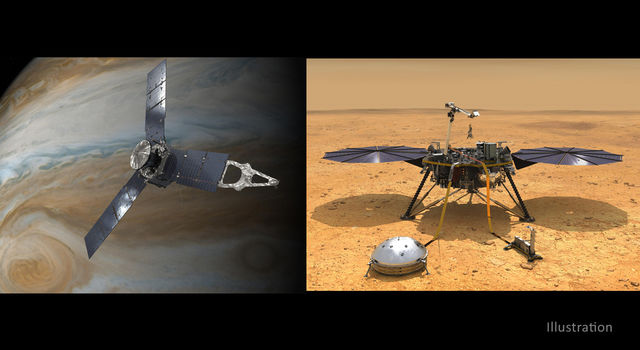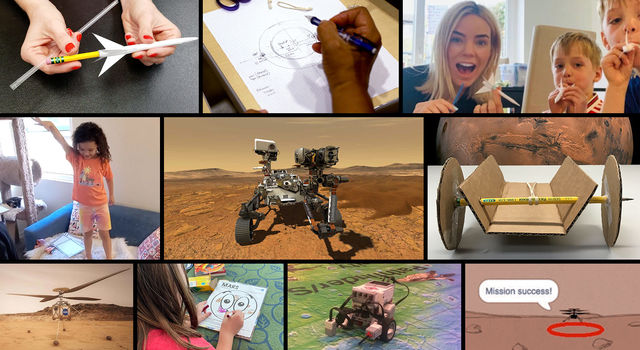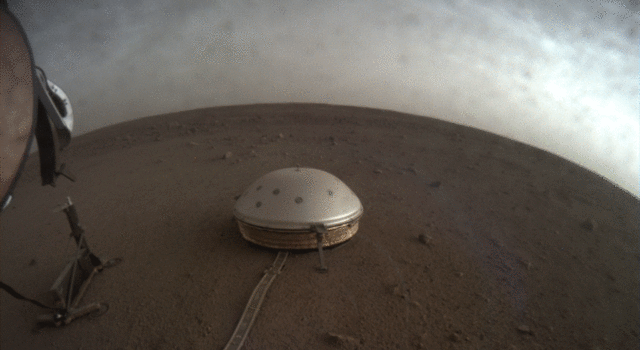Blogs | Dawn Journal | April 26, 2009
April 2009
Dear Dawngrades,
The upgraded Dawn spacecraft is now traveling in a new direction in its orbit around the Sun. The mission continues to go smoothly during this long coasting period, scheduled to conclude in June, when powered flight with the ion propulsion system will resume.
Dawn has many computers in its onboard crew and one that serves as the captain of the ship. This primary computer’s software had been unchanged since February 2008. That last modification involved only a small patch, making version 7.0.3 of the software. That was preceded by a small update in January 2008 and one in December 2007. Prior to this month, Dawn had had only one complete in-flight replacement of its main software, in November 2007.
In January 2008, engineers began working on the next major upgrade in software. It was scheduled for the coasting period after the Mars gravity assist, and here we are! To maintain the sense of majesty that fuels the passions of those who yearn to explore the cosmos and long to discover its secrets, the software was given a name to suit its important role in this grand endeavor: OBC flight software version 8.0. Demonstrating an irrepressible sense of humor, though, most members of the team enjoy referring to it by its screwball nickname, “eight oh.” Sometimes the public may wonder how such serious and challenging work can be accomplished amidst such antics in the Dawn section of JPL’s building 264!
Software 8.0 contains 34 changes. These range from improvements to make more efficient use of the extremely low rate of transmission of data from the spacecraft when it uses one of its small auxiliary antennas (as it does in safe mode and in some other circumstances), to methods to expedite recoveries from certain causes of safe mode, to increasing the robustness of the handling of some conditions that, while highly unlikely ever to arise, could be very serious. A few bugs, inevitable in software of this complexity, also were fixed. Indeed, readers who are about 7 weeks behind in these logs are just now learning that the bonus instrument calibrations during the crucial and successful gravity assist at Mars were interrupted by the combination of two bugs, neither of which by itself would have been sufficient to affect the activity. One of them, which prevented the backup star tracker from being called into use when needed quickly, was corrected in this version of the software.
The process of loading software, particularly into the main computer, is complex and delicate. The spacecraft constantly relies upon that computer for keeping the solar arrays pointed at the Sun to generate electrical power for all systems, maintaining components at the correct temperatures despite the extreme conditions of spaceflight, aiming the antenna at Earth, and performing a great many other functions vital to Dawn’s operation. Should the loading of the new software go awry or introduce new bugs along with the intended changes, the consequences could be less than felicitous. A substantial effort was devoted to careful and thorough testing of the software in computer simulators on Earth, and the techniques and procedures for installing it on the most important computer, the one in deep space, were tested and rehearsed extensively as well.
As explained in December 2007, Dawn has a primary main computer, with primary and backup copies of the software, and an identical backup computer, also with primary and backup copies. On April 10, mission controllers verified that the backup copy in the primary computer and both copies residing in the backup computer were pristine, uncorrupted by radiation or any other anomalies since they had been loaded. If a problem developed while loading 8.0, the team was confident the spacecraft could resort to familiar and healthy software if need be.
On April 13, the new software was transmitted to the spacecraft. Dawn receives commands from large antennas of the Deep Space Network at 2000 bits per second. While this would seem agonizingly slow for our terrestrial readers located in the 21st century, that is the maximum rate for NASA’s interplanetary probes. Most sets of instructions bound for the spacecraft are short enough that they consume no more than a few minutes of transmission time (regardless of how long it takes the signals to travel to the spacecraft). The file containing the software was so large that the time required to transmit it was far longer than the nearly 18 minutes needed for radio signals (which, as regular readers know, travel at the universal limit of the speed of light) to traverse the vast distance to the craft. So, during the loading of the software, Earth and Dawn were connected by an uninterrupted bond, a radio link 320 million kilometers (199 million miles) long. Even as Dawn was accepting the signals, still more were being sent. An unbroken line of 0’s and 1’s, each bit 150 kilometers (93 miles) long, stretched through space, connecting the probe to its erstwhile home.
In addition to 8.0 onboard (and verifying that it did indeed arrive intact, with no dropouts, no errors, no miscommunications whatsoever), engineers conducted other checks and reconfigured systems to prepare for running the new software. Additional preparations and final verifications were conducted on April 14.
With all stations in mission control early that afternoon reporting their subsystems were ready, the final “go” was given, and the command to reboot the computer for the first time since November 2007 was transmitted. In addition to causing the computer to run the new software, this triggered the spacecraft to enter safe mode, as expected. (Somewhat less directly, it also triggered pizza to be delivered to mission control a few hours later.) Because safe mode does not use the main antenna but rather one of the smaller, auxiliary antennas, the operations team scheduled this delicate operation to occur under the watchful eye of the 70-meter-diameter (230-foot-diameter) radio antenna of the Deep Space Network complex near Canberra, Australia, rather than one of the 34-meter (112-foot) antennas. With the larger antenna, engineers could more quickly verify the new software was operating correctly and begin the long process of returning the spacecraft to its normal configuration.
The operations team took advantage of these activities to make another planned change. Safe mode employs all 4 of the reaction wheels, components which can be electrically spun faster or slower to help stabilize the spacecraft or rotate it. In normal operations, only 3 are used; wheel #2 had its turn to be dormant starting in October 2008. In commanding Dawn out of safe mode, controllers kept wheel #2 on and powered off #1.
By April 16, the spacecraft was fully reconfigured, and engineers continued to be happy with the functioning of the new software. While a great deal of work had gone into preparing for a wide variety of problems that could have occurred because of loading the software or that could have been more troublesome had they cropped up by coincidence during this sensitive operation, it all proceeded quite smoothly indeed.
We will report in the next log on installing the backup copies of the software and on further verifications that 8.0 is up to the job of continuing the mission that had been progressing so well with 7.0.3.
If you wish to download 8.0 for use at home (or on your spacecraft), you may obtain a copy directly from the main computer on Dawn. The computer is inside the box labeled “CEU A,” conveniently located under the -y panel of the spacecraft. Don’t forget to bring your own cable, and please be careful not to damage the delicate solar cells on the nearby wing.
Engineers have already begun work on the next version of the software, this one having the sleek and chic sobriquet “nine oh.” It will be sent to the spacecraft in 2010; and at that time, we surely will have occasion to link back to this log, so readers are advised to retain a copy for reference. (Some may wish to preserve this log purely as an investment. Dawn financial analysts predict that when it is cited in next year’s description of 9.0, its value might rocket to as much as 2% more than you paid for it.)
As it resumed normal operations with its new software, Dawn reversed one component of its course through space. Since August 8, 2008, it had been falling toward the Sun. Thanks to the principles of orbits, it was not in danger of reaching that star or even getting close enough to be singed. The ship is in an elliptical orbit, whose innermost point was reached on April 17 (at about 5:07 pm PDT, for those of you who wondered what seemed to change around that time). The probe was 205 million kilometers (127 million miles) from the Sun. We may recall a measurement unit more convenient than kilometers or miles, the astronomical unit (AU), in which 1 AU is the average distance between Earth and the Sun. With that handy ruler, Dawn was 1.37 AU from the star. After passing through that low point in its current orbit, momentum began carrying it farther from the Sun again.
Thanks to the effects of the ion thrusting in the next few years, it will continue to follow an outbound path until late 2012, when once more it will temporarily approach the Sun. It will never again be as close to the solar system’s center as it was this month, for the craft will have to climb to more than 2.2 AU to reach Vesta and to more than 2.9 AU as it orbits Ceres.
In preparation for its work there, on March 31, the spacecraft conducted another test of its primary science camera, which has performed flawlessly during the mission. It will be used not only to acquire exciting views of the alien surfaces of the unexplored worlds it is bound for, but also to help refine the location of those faraway and mysterious bodies so Dawn’s navigators can guide the probe into orbit. To plan for the most productive observations, the team needs to understand the detailed performance of the instrument under the full range of conditions in which it might be used. Can the camera point as close to the Sun as will be desired, without unwanted light compromising exquisite details in the pictures? Well, it is quite a coincidence that you, loyal reader, just now began thinking of that particular question, because the purpose of this test was to answer it.
The spacecraft started by pointing the camera 90 degrees from the Sun. It took a set of pictures, then rotated to aim a little closer to the Sun and took more, continuing through a range of 60 degrees. To imagine this, let’s take advantage once again of one of the many exotic Dawn clocks available in the Dawn gift shop (be sure to visit the shop on your planet soon to see the exciting new line of fashionable Dawnderwear). In this clock, the spacecraft is at the center, and the Sun is at the top, where the 12 would be. To begin, the craft pointed the camera toward the 9. After taking its pictures, it turned by 2.5 degrees, or about the same angle the second hand would move in just over 0.4 seconds. It stopped again and obtained more images. It continued with this pattern until it was directed at the 11, which was the closest it could point safely to the hot star at its current distance.
As with most clocks in the gift shop, this one might not be the best choice for something as mundane as telling time. Allowing time for each turn, stabilizing at each position, and then acquiring all the pictures, it took Dawn 12 hours to rotate from the 9 to the 11, or 6 times slower than the hour hand moves. This long test yielded 410 images at 25 different angles from the Sun, allowing engineers to determine if stray light could find its way to the camera’s detectors by any circuitous path, reflecting off components within the complex camera. Once again, the unit performed superbly. Even with exposures as long as 100 seconds, unwanted light did not reach appreciable levels.
Now flying under the control of new software and confident its camera will operate under all necessary conditions, Dawn is headed deeper into space again. Still more tasks lie ahead before it resumes its familiar routine of sustained thrusting with the ion propulsion system. The subsequent log, which we boldly predict will follow this one, will describe the next series of special activities.
Dawn is 315 million kilometers (196 million miles) from Earth, or 855 times as far as the moon and 2.09 times as far as the Sun. Radio signals, traveling at the universal limit of the speed of light, take 35 minutes to make the round trip.
Dr. Marc D. Rayman
4:00 am PDT April 26, 2009
TAGS:DAWN, VESTA, CERES, DWARF PLANET, MISSION, SPACECRAFT







